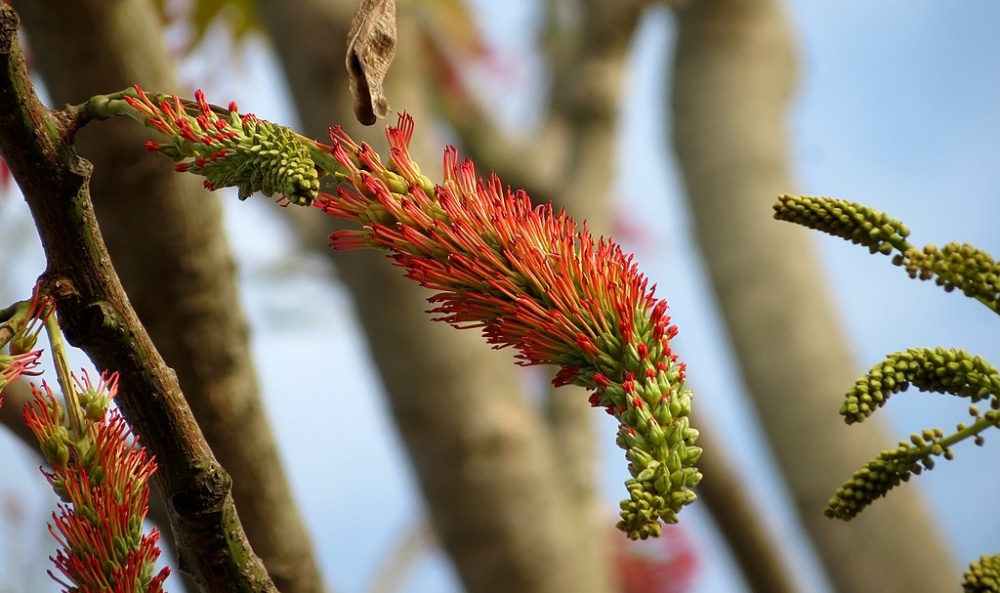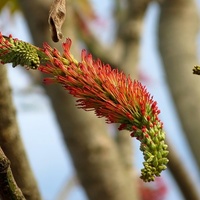Common name: Pink cedar
Other common names: Kenya coffeeshade, Indian ash, Red cedar, Shingle tree
Description
Pink cedar or Mundani is a fast-growing flowering and timber tree native to parts of the Indian subcontinent and Southeast Asia. Its natural range extends from the foothills of the Himalayas east to forested highland areas in Myanmar (Burma), Thailand and Indonesia.
It may reach heights of up to 50 m (164 ft) under favourable forest conditions with a 2 m (6.6 ft) diameter trunk, usually buttressed at the base, unbranched for half its height and supporting a compact columnar or pyramidal crown. The bark is grey to grey-brown and dotted with raised, wart-like pores known as lenticels.
The leaves are huge and twice-feathered, consisting of as many as forty ovate leaflets, each up to 10 cm (4 in) long and arranged in pairs along the leaf branches. They are shed in the dry season to conserve water, leaving the tree mostly bare and leafless until the rainy season. The new leaflets, when they emerge, are bright red, giving a colourful display before gradually ageing to green.
Equally showy are the orange to red flowers that bloom when the tree is leafless, reaching full bloom by the end of the dry season. Fertilised flowers develop into long, flat and winged seedpods that turn brown when mature, about six weeks after the flowering period has ended.

Photo by Forestowlet
Use
Pink cedar produces a medium-weight wood, averaging around 630 kilograms per cubic meter (39 lbs per cubic ft), making it a hardwood. However, its low natural resistance to decay and termites limits its use outdoors.
The heartwood is an attractive dark red, and well-formed logs are sawn into planks for making light articles such as crates, pallets and boxes, including boxes for beehives. It was much used in the past for making large tea chests, in which Tea (Camellia sinensis) from India was shipped worldwide.
The roundwood is easily split and has long been used to make roof shingles. It is also cut for fence posts and is widely used for firewood and for making charcoal.
Its fast growth rate makes it a suitable tree for crop shading, especially for tropical highland crops such as Coffee (Coffea arabica) and Tea (Camellia sinensis). It is occasionally cultivated in large gardens and parks to appreciate its feathery foliage and showy flowering display.
The flowers produce abundant nectar that attracts and nourish nectar-feeding birds and possibly honeybees. Still, there does not appear to be any reliable information on its value to bee forage or honey production.
Climate
Grows naturally and has its best development in humid subtropical and tropical lowland to mid-elevation climates, generally in frost-free areas with annual lows of 13 to 22°C, annual highs of 23 to 34°C, annual rainfall of 1300 to 5000 mm and a dry season of 5 months or less.
Trees in low rainfall areas or areas with a pronounced dry season tend to develop short trunks, narrow crowns and have a low survival rate.
Growing
New plants are usually started from seed, which can be pre-treated to improve germination by immersing them in hot water that is then left to cool. Once established, it performs best on free-draining clay, loam and sand soils of a slightly acid to slightly alkaline nature, generally with a pH of 6.0 to 7.5 and on sites with full to partial sun exposure.
Problem features
The winged seedpods are designed for dispersal by wind, which can carry them afar, and because the seed germinate readily, it may cause it to be potentially invasive. It is listed as a weed in at least one reference publication. Still, there does not appear to be any records of it being a serious weed anywhere, despite being long introduced into areas outside of its native range.
Where it grows
References
Books
-
Allen, O. N. & Allen, E. K. 1981, The Leguminosae : a source book of characteristics, uses, and nodulation, University of Wisconsin Press, Madison, Wisconsin
-
Barwick, M., et al. 2004, Tropical & subtropical trees : a worldwide encyclopaedic guide, Thames and Hudson, London
-
Burns R.M., Mosquera M.S. & Whitmone J.L. 1998, Useful trees of the tropical region of North America, North American Forestry Commission Publication (Number 3), Washington D.C.
-
Champion, H. G. & Seth, S. K. 1968, A revised survey of the forest types of India, Natraj Publishers, Dehradun, India
-
Elevitch, C. R & Wilkinson, K. M. 2000, Agroforestry Guides for Pacific Islands, 1st ed., Permanent Agriculture Resources, Holualoa, Hawaii
-
Krishen, P. 2006, Trees of Delhi : a field guide, Dorling Kindersley Publishers, Delhi
-
Lemmens R.H.M.J., Louppe, D. & Oteng-Amoako, A.A. (Editors) 2012, Plant Resources of Tropical Africa, Volume 7(2) : Timbers 2, PROTA Foundation, Backhuys Publishers, Leiden
-
Luna, R. K 1996, Plantation trees, International Book Distributors, Dehradun, Uttarakhand
-
Macmillan, H. F. 1943, Tropical planting and gardening : with special reference to Ceylon, 5th ed, Macmillan Publishing, London
-
Menninger, E. A. 1962, Flowering trees of the world for tropics and warm climates, 1st ed., Heathside Press, New York
-
National Research Council (Board on Science and Technology for International Development) 1979, Tropical legumes : resources for the future, The National Academies Press, Washington D. C.
-
Randall, R. P. 2002, A global compendium of weeds, R.G. and F.J. Richardson Press, Melbourne
-
Randall, R. P. 2007, The introduced flora of Australia and its weed status, Cooperative Research Centre for Australian Weed Management, Glen Osmond, South Australia
-
Roecklein, J. C & Leung, P.S. 1987, A Profile of economic plants, Transaction Books, New Brunswick, New Jersey
-
Scheffer, T. C & Morrell, J. J. 1998, Natural durability of wood : a worldwide checklist of species, Forest Research Laboratory, Oregon State University, Corvallis, Oregon
-
Streets, R. J. & Troup, R. S. 1962, Exotic forest trees in the British Commonwealth, Oxford University Press, Oxford, England
-
Vozzo, J. A 2002, Tropical tree seed manual, U.S. Department of Agriculture (USDA), Forest Service, Washington D.C.
-
Webb, D. B. 1984, A Guide to species selection for tropical and sub-tropical plantations, 2nd ed., Unit of Tropical Silviculture, Commonwealth Forestry Institute, University of Oxford, Oxfordshire
Articles, Journals, Reports and Working Papers
-
Macdonald, I.A.W., J.K. Reaser, C. Bright, L.E. Neville, G.W. Howard, S.J. Murphy & G. Preston (eds.). 2003. Invasive alien species in southern Africa: national reports & directory of resources. Global Invasive Species Programme, Cape Town, South Africa.


